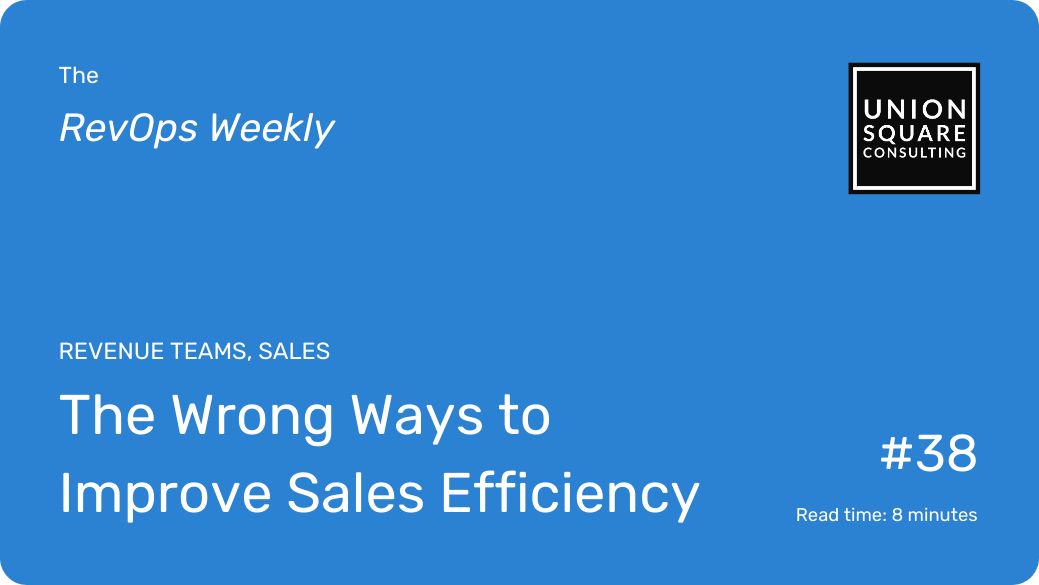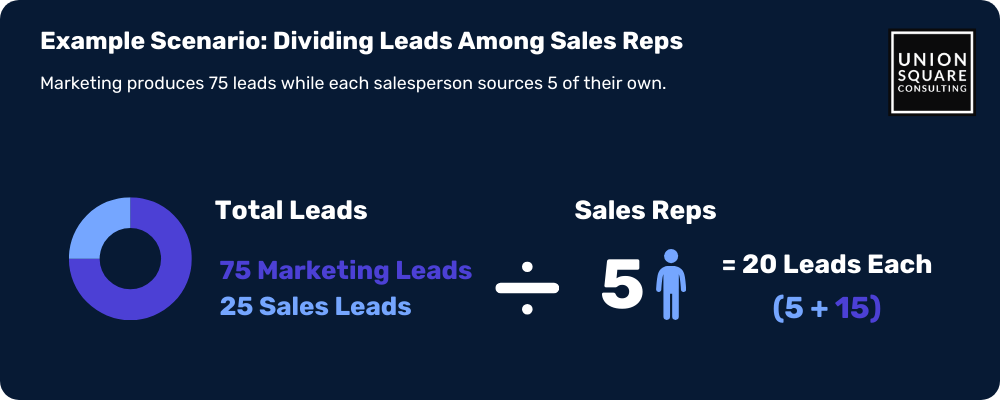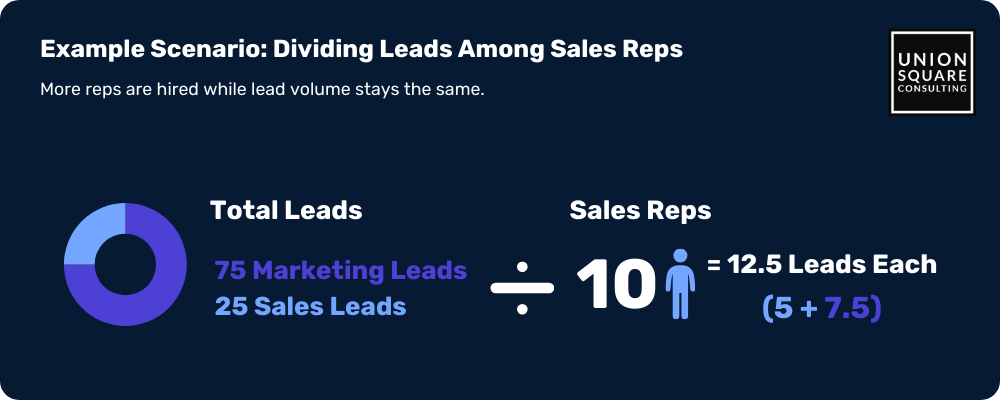
The Wrong Ways to Improve Sales Efficiency
Read time: 8 minutesThis may sound a bit philosophical, but I find that companies commonly fail to improve sales efficiency because they don’t actually try to improve sales efficiency.
They try to improve sales.
They see the symptoms of an inefficient sales organization, such as:
- Long sales cycles
- Low conversion rates
- Low sales productivity
Then they think, “we’re not selling enough, we need to sell more.”
“Selling more” is usually too simplistic of a goal on its own and often leads to misguided “solutions” that can cause more harm than good.
Such as:
- Increasing workload without understanding capacity
- Standing up an SDR team for the wrong reasons
- And hiring more sales reps prematurely
In this newsletter, we’re going to discuss these common mistakes – plus a bonus section on actually improving sales efficiency in both the short and long term.
Mistake #1: Increasing Workload Without Understanding Capacity
Taking the same people that you have right now and trying to get more out of them can be a perfectly rational way to improve sales efficiency. After all, more sales plus the same number of people equals a more efficient system. Not necessarily a bad thing.
The problem is that companies try to do this blindly, without understanding whether or not they have the ability to sell more with the same team.
Even though “we need to sell more” is an efficiency problem at the end of the day, it’s a huge mistake to try to create efficiency this way if you haven’t done capacity planning and don’t know the limits of your reps.
To learn more about capacity planning for Sales, check out our recent newsletter on the topic.
Mistake #2: Standing Up an SDR Team for the Wrong Reasons
A lot of companies think an SDR will come in and create a hundred new meetings a month immediately.
Maybe this used to be realistic, but nowadays it’s a lot harder to be an SDR. People are aware of the SDR game and don’t want to pick up the phone when an unknown number calls.
So when companies hire an SDR team to solve a sales efficiency problem, they:
- Expect immediate payoff
- Don’t equip the team properly
- End up spending a bunch of money
- And then shut it down a couple of years later
Instead, it’s better to view the SDR team as a proving ground for future AEs first, and a path to lower CAC second.
While you’re in growth mode, it’s incredibly helpful (and much lower risk) to be able to promote people to AE when they’re already halfway ramped; they know the product, know the market, can have business conversations, etc.
Having your SDR team act as kind of an “apprenticeship program” for AEs is going to be worth more than the leads they generate.
Likely less than half of your SDRs will be good enough at the role to go on to do the job of an AE. The rest will be under-performers, and that’s just the way it is.
Yes – SDRs create more lead flow. But if you’re building an SDR team purely for the sake of raking in more sales and curing your sales efficiency problem, you may be disappointed in the outcome.
As I said, this hasn’t always been the case, but business rationale has changed in the last few years. People need to go in “eyes wide open” to this play in the playbook.
Mistake #3: Hiring More Sales Reps Prematurely
Expanding your sales team does not necessarily mean more revenue.
If your existing team isn’t performing, adding headcount is more likely to further reduce quota attainment across the board.
Here’s an excerpt from our newsletter, “Will Hiring Salespeople Stimulate Growth?”, where we go into this in-depth:
A salesperson is a portion of a workflow that has a certain capacity, and if you’re not utilizing that capacity, the answer isn’t adding more capacity.
Let’s visualize this. Say your company generates 100 leads a month and you have 5 salespeople. Your salespeople generate 25 of those leads (5 leads per salesperson) and Marketing generates the other 75.
If you add 5 more salespeople, without changing anything else (i.e., fixing any root problems), then each salesperson just went from having 20 leads to work (their 5 plus 15 from Marketing) to only having ~12 to work (5 plus 7.5 from Marketing).
If your team wasn’t hitting quota before, they’re certainly worse off now – while you just drastically increased your expenses.
If you’re not at 80% sales attainment with everybody (or nearly everybody) on your sales team, adding more salespeople will only further dilute your team’s profitability. Instead, investigate the reason behind the low sales attainment, make that your next project, and revisit the idea of hiring once the team is better supported.
You should be hiring salespeople when you have an overflow of opportunity, not because you have a lack of it.
Better Ways to Improve Sales Efficiency
Now that we’ve gone over the things you shouldn’t do, let’s talk about the things you CAN do to improve sales efficiency.
There are two ways to go about this:
Short-term wins: things that will immediately make you more efficient.
Long-term wins: processes throughout your org that increase foundational efficiency.
My favorite short-term sales efficiency tactic – one that often gets overlooked despite its simplicity – is to have clear SLAs at the beginning and end of the sales process and stick to them.
This means:
- Following up on leads in the right time
- Having a consistent process to your sales flow
- Having an organized sales handoff post-sale and smooth kickoff
Everyone on your sales team should understand these expectations and follow them, both before and after a contract is signed.
If you do this, you will immediately improve your efficiency and revenue potential.
Now, let’s talk about the long term.
One of the main goals of Revenue Operations is to create alignment – this is well-known.
Another goal of Revenue Operations is to create mechanisms for positive or virtuous feedback loops.
One of the biggest feedback loops that companies don’t take advantage of, is the connection between the sales process and the product and customer lifecycle.
There is a goldmine of information here just waiting to be analyzed and fed back into the system.
During sales:
- Why did we win or lose that deal?
- What product features are exciting?
- Which features got a lackluster reaction?
When they’re already a customer:
- How are we doing?
- What do they like about the product?
- What does their usage data look like?
- Do you survey customers online or in person?
Some companies ask their best customers to all meet up once a year in a major city to have a nice free dinner, discuss the product, and provide feedback.
Customers love this stuff. They feel like they’re being taken care of, that their voice matters, and that they’re getting a lot of value in your partnership.
But this also creates all these internal mechanisms for feedback that you can act on.
- Are we priced too high or too low?
- Are we aligned to the right customer?
- Are we developing things they don’t need?
- Do we need to market a different message?
- Are we drifting away from Product Market Fit?
A lot of companies talk to their customers, but few use this info to inform the direction of the organization. And that is one of the most impactful things you can do for long-term sales efficiency – and overall brand success.
You’ll develop better products, you’ll have happier customers, and you’ll have a lot more testimonials and case studies for marketing content and sales enablement.
How does a B2B SaaS scale-up bake these feedback loops into their organizational processes – and benefit from them?
We do it for you as a part of our Strategic RevOps Services.
Having fractional Revenue Operations experts in your corner is a fast-track to finding, fixing, and preventing inefficiencies throughout your organization.
Is there a problem on your mind that you’re wondering if we can fix? Reply to this email and lay it on us. Our CEO, Eddie Reynolds, will personally respond as soon as he’s able.
TL;DR
- Companies fail in improving sales efficiency by focusing on sales instead
- Mistake 1: They increase workload without understanding capacity
- Mistake 2: They stand up an SDR team for the wrong reasons
- Mistake 3: They hire more sales reps prematurely
- Instead, improve short-term sales efficiency by:
- Following up on leads in the right time
- Having a consistent process to your sales flow
- Having an organized sales handoff and smooth kickoff
- Improve long-term efficiency by:
- Creating positive feedback loops between sales cycle and customer lifecycle
- We can help you accomplish this with our Strategic RevOps Services
When you’re ready, here’s how we can help:
Get a Free 1:1 Revenue Efficiency Workshop
Get one of our Senior Revenue Strategists to yourself for 1 hour and leave with a plan to increase the money-making power of your go-to-market operations.
Hire Us!
Bring us on as your Strategic RevOps Team and realize the growth potential of your revenue engine. There are 3 ways to work with us.
Get more tips like these, sent right to your inbox.
Subscribe for fresh, relevant revenue growth tips delivered every week.
